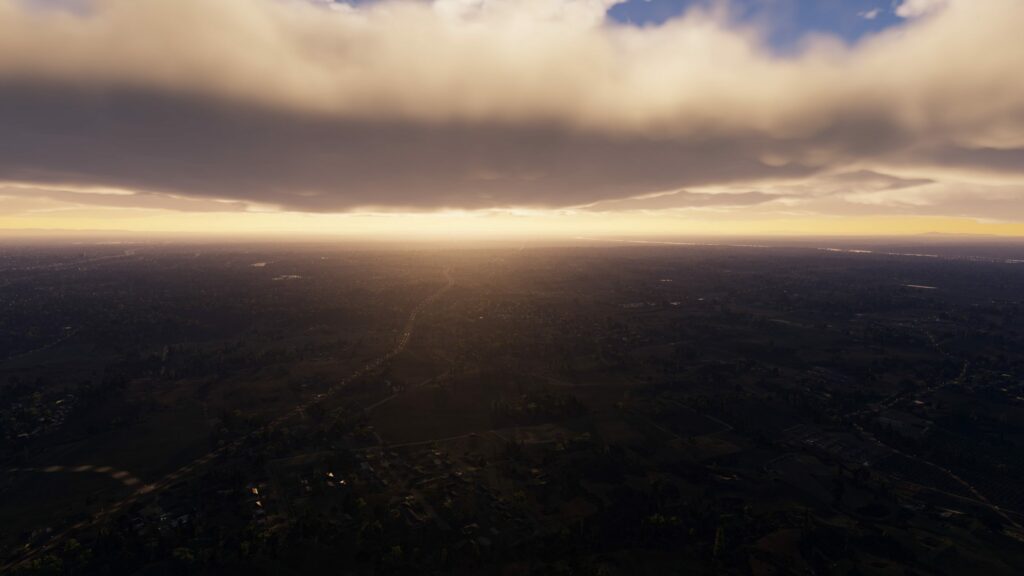
Auch wenn er es nicht mehr so oft in die Schlagzeilen schafft: Die Arbeit an Prepar3D geht weiter. Das neueste Update von Prepar3D, Version 6.1, bringt eine Vielzahl neuer Funktionen und Verbesserungen für die Flugsimulationsplattform.
Hervorzuheben sind laut Update-Seite die Unterstützung von FSR2 und DLSS/DLAA (exklusiv für Nvidia 2000er-Serienkarten und höher), die Skalierung der Auflösung für Bildverbesserung und Spiegelungen im Bildraum (SSR). Das Update führt außerdem Contrast Adaptive Sharpening (CAS) ein und speichert den aktuellen Flugplan mit Aufzeichnungen.
Verbesserungen betreffen verschiedene Aspekte, wie hochdetaillierte 3D-Baummodelle mit Windunterstützung, Rotorwascheffekte auf Vegetation und Niederschlagseffekte auf Pflanzen. Die Effekte für Nachtsichtsensoren wurden verbessert, und es gibt Aktualisierungen für globale Szenerien, Hubschrauberlandeplätze und Texturen von Flughafengebäuden.
Die Flugplanung erfährt Verbesserungen durch die Integration von aktualisierter Navdaten der Coded Instrument Flight Procedures der FAA. Fehlerbehebungen adressieren Probleme wie Terrainspitzen, Probleme mit Flughafenoberflächen und Windschutzscheibeneffekte bei Standardflugzeugen.
Die Professional Plus-Version bietet außerdem zusätzliche Funktionen zur Unterstützung von Varjo-Mixed-Reality-Headsets. Darüber hinaus führt das Prepar3D SDK neue Funktionen ein, wie z.B. die Unterstützung der Tiefenschärfe, das „Camera Facing Normals“-Flag für PBR-Materialien und erweiterte GPS-Variablen.
Prepar3D Version 6 war im Sommer kurz nach der FSExpo erschienen. Mehrere große Add-on-Hersteller erklärten im Zuge des neuen MSFS-Marktes dann, dass sie mit ihren Produkten den neuesten P3D nicht mehr unterstützen werden.
Hier das Changelog im Original:
General Platform Updates
New Features
- Added support for FSR2 and DLSS/DLAA. Note: DLSS/DLAA is only available with Nvidia 2000 series cards or above.
- Added Resolution Scaling support for image upsampling and supersampling.
- Added screen space reflections (SSR).
- Added Contrast Adaptive Sharpening (CAS).
- Current flight plan is now saved and loaded with flight recordings.
- Updated various tree models to highly detailed 3D versions with wind support.
- Added LoadFlightPlanAction to SimDirector allowing for flight plan to be loaded for ownship or player objects.
- Added two-sided thin shading model allowing for greater detail in tree rendering.
- Rotor wash is now supported on vegetation.
- Precipitation effects are now supported on vegetation.
- Improved performance for autogen vegetation including LOD support.
- Added additional terrain detail textures.
- Glide path angle is now calculated and available through GPS system.
- Added runway transition support to arrivals.
- Updated navdata from the FAA’s Coded Instrument Flight Procedures (CIFP).
Fixes and Improvements
- Improved night vision sensor effect visuals.
- Additional airport fixes and airport surface improvements.
- Various updates to global scenery, helipads, and airport building textures.
- Fixed terrain spike in French southern Antarctic.
- Fixed several terminal building and parking issues at KDTW and KOAK.
- Added 2D panel windows for F-16 LMFD, RMFD, and DED panels.
- Various updates to scenery models in major global cities.
- Fixed windshield effect for various default aircraft.
- Fixed flattening polygon issue in Australia and KTEX, and Telluride.
- Golden gate bridge is now PBR.
- Improved patch installation times.
- Fixed detail texture sampling issues when camera is far away from its initial starting point.
- Added Prepar3D.cfg option to disable blacking out 3D views when entering the UI.
- Fixed issue where calculating flight plan would override user cruising altitude values.
- Fixed issue where restoring bypassed legs in flight plan would not reconnect flight plan points.
- Fixed issue where multiple direct-to calls on procedure points would not set the active waypoint correctly.
- Improved TAA performance.
- Opening the Fuel and Payload screen no longer pauses the simulation.
- Navigation log now updates procedure points.
- Fixed issue where navigation log wouldn’t update on scenario load.
- Fixed cases where parts of SIDs and STARS were being skipped with certain transition IDs.
- Scenery Library layers can now be modified using a numeric text box.
- Improved Scenery Library drag and drop layer changing performance.
- Fixed bug preventing runway transitions flagged as both would not load.
- Fixed bug where runway fix would not load for some approaches.
- Improved shader compilation handling at runtime.
- Fixed issue where adding new objects in SimDirector could cause visualization graph to rearrange nodes when automatic graph layout was disabled.
- Fixed blend mode issue that could cause certain materials to become overly bright.
- Fixed issue where invalid waypoints in flight plan could prevent remaining valid points from connecting properly.
- Fixed issue that could cause layering issues with certain add-on airports.
- Fixed timing issues with Select Airport screen that could cause incorrect airport from being selected in some cases.
- Improved rendering performance of virtual cockpit only views.
- Tuned PAPI light intensities.
- Improvements to bloom appearance when using TAA.
- Fixed emissive script behavior for legacy PBR materials that could lead to washed out textures at night.
- Various fixes to ATG radar system including issues with beam heading and FOV settings.
Fixes and Improvements (Professional Plus Only)
- Additional updates to better support Varjo mixed reality headset features.
- Fixed issue with effects not drawing on multiple displays connected to the same multichannel client.
Prepar3D SDK
New Features
- Day/Night, Sun/Moon, Exposure, and Emissive interpolant values are now accessible through the PDK.
- Added depth of field support through camera configuration and PDK.
- Added “Camera Facing Normals” flag to PBR material.
- Added “Has Pixel Movement” flag to PBR material.
- Added additional GPS variables including:
- FlightPlanWaypointApproachAltitude2
- FlightPlanWaypointArrivalAltitude2
- FlightPlanWaypointDepartureAltitude2
- FlightPlanWaypointApproachAltitudeDesc
- FlightPlanWaypointArrivalAltitudeDesc
- FlightPlanWaypointDepartureAltitudeDesc
- FlightPlanWaypointApproachGlidePathAngle
- FlightPlanWaypointArrivalGlidePathAngle
- FlightPlanWaypointDepartureGlidePathAngle
- FlightPlanWaypointMagneticVariation
- FlightPlanApproachWaypointMagneticVariation
- FlightPlanArrivalWaypointMagneticVariation
- FlightPlanDepartureWaypointMagneticVariation
- FlightPlanApproachRemoveLegIndex
- FlightPlanArrivalRemoveLegIndex
- FlightPlanDepartureRemoveLegIndex
- FlightPlanApproachDirectToLegIndex
- FlightPlanArrivalDirectToLegIndex
- FlightPlanDepartureDirectToLegIndex
- FlightPlanApproachDirectFromLegIndex
- FlightPlanArrivalDirectFromLegIndex
- FlightPlanDepartureDirectFromLegIndex
Fixes and Improvements
- Adjusted Weather Radar sample scale of precipitation in volume cloud to better align weather radar values between volume clouds and legacy clouds
- Fixed several typos in Learning Center CIGI, SimConnect, and window plugin documentation.
- Moved several post processes from core to SDK as samples.


Uups, die sind immer für eine Überraschung ohne Ankündigung gut. Schaun wir mal
Irgendwie schade, ich hatte bestimmt an die 1000 € für P3D Addons ausgegeben. Letztlich hat es sich aber nicht gelohnt, da ich kurz darauf zu X-Plane 11 und später zu X-Plane 12 gewechselt bin. Aber wer weiß, für was für Überraschungen die noch gut sind?
P3D war jahrelang mein Begleiter, keine Ahnung, was ich ausgegeben habe… aber ich finde einfach nicht mehr zurück ….
Ich bin bei der Version 6 wieder eingestiegen und happy, dass ich fast alle meine alten Addons wieder reaktivieren konnte. Mit den neuen Features macht mir das unheimlich viel Spaß und ich fliege immer häufiger wieder mit Prepar3D. Schön, dass man die Wahl hat.